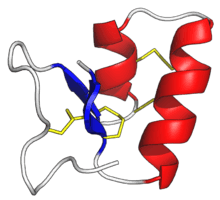Thionin
Thionins (without an e) are a family of small proteins found solely in higher plants. Typically, a thionin consists of 45–48 amino acid residues. 6–8 of these are cysteine forming 3–4 disulfide bonds. Some thionins have cytotoxic activity and they are therefore interesting in the development of new drugs against cancer with novel action mechanisms.[1] No thionin has yet been developed into an anti-cancer drug. Alpha- and beta- thionins are related to each other. Gamma thionins have a similar structure but are an unrelated class of protein, now called plant defensins.
The proteins are toxic to animal cells, presumably attacking the cell membrane and rendering it permeable: this results in the inhibition of sugar uptake and allows potassium and phosphate ions, proteins, and nucleotides to leak from cells.[2] Thionins are mainly found in seeds where they may act as a defence against consumption by animals. A barley (Hordeum vulgare) leaf thionin that is highly toxic to plant pathogens and is involved in the mechanism of plant defence against microbial infections has also been identified.[3] The hydrophobic protein crambin from the Abyssinian kale (Crambe abyssinica) is also a member of the thionin family.[2]
Databases
A database for antimicrobial peptides, including thionins is available: PhytAMP.[4]
See also
References
- ↑ Florack DE, Stiekema WJ (October 1994). "Thionins: properties, possible biological roles and mechanisms of action". Plant Mol. Biol. 26 (1): 25–37. doi:10.1007/BF00039517. PMID 7948874.
- ↑ 2.0 2.1 Vernon LP, Evett GE, Zeikus RD, Gray WR (1985). "A toxic thionin from Pyrularia pubera: purification, properties, and amino acid sequence". Arch. Biochem. Biophys. 238 (1): 18–29. doi:10.1016/0003-9861(85)90136-5. PMID 3985614.
- ↑ Apel K, Andresen I, Becker W, Schluter K, Burges J, Parthier B (1992). "The identification of leaf thionin as one of the main jasmonate-induced proteins of barley (Hordeum vulgare)". Plant Mol. Biol. 19 (2): 193–204. doi:10.1007/BF00027341. PMID 1377959.
- ↑ "PhytAMP Database". ; Hammami R, Ben Hamida J, Vergoten G, Fliss I (January 2009). "PhytAMP: a database dedicated to antimicrobial plant peptides". Nucleic Acids Res. 37 (Database issue): D963–8. doi:10.1093/nar/gkn655. PMC 2686510. PMID 18836196.
|
|---|
| | Arrestin | |
|---|
| | Membrane-spanning 4A |
- MS4A1
- MS4A2
- MS4A3
- MS4A4A
- MS4A4E
- MS4A5
- MS4A6A
- MS4A6E
- MS4A7
- MS4A8B
- MS4A9
- MS4A10
- MS4A12
- MS4A13
- MS4A14
- MS4A15
- MS4A18
|
|---|
| | Myelin | |
|---|
| | Pulmonary surfactant | |
|---|
| | Tetraspanin | |
|---|
| | Other/ungrouped | |
|---|
| see also other cell membrane protein disorders
Index of cells |
|---|
| | Description |
- Structure
- Organelles
- peroxisome
- cytoskeleton
- centrosome
- epithelia
- cilia
- mitochondria
- Membranes
- Membrane transport
- ion channels
- vesicular transport
- solute carrier
- ABC transporters
- ATPase
- oxidoreduction-driven
|
|---|
| | Disease |
- Structural
- peroxisome
- cytoskeleton
- cilia
- mitochondria
- nucleus
- scleroprotein
- Membrane
- channelopathy
- solute carrier
- ATPase
- ABC transporters
- other
- extracellular ligands
- cell surface receptors
- intracellular signalling
- Vesicular transport
- Pore-forming toxins
|
|---|
|
|
